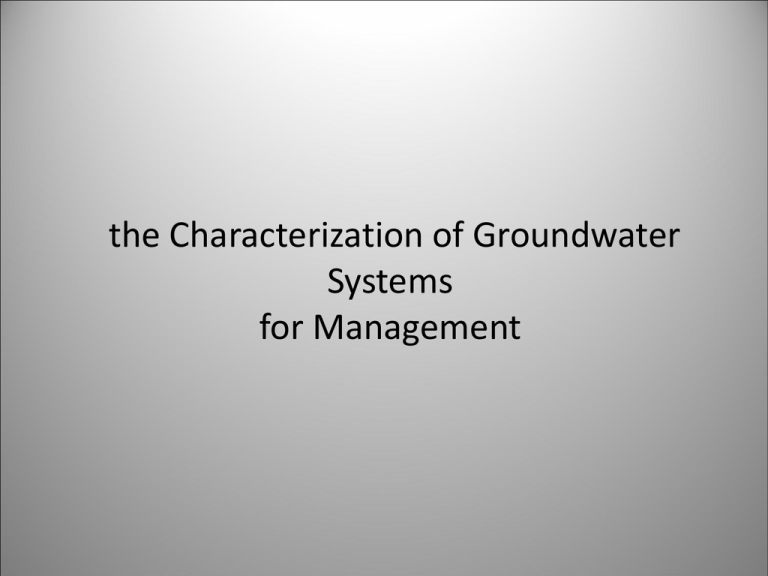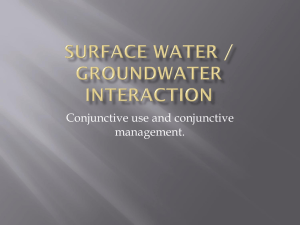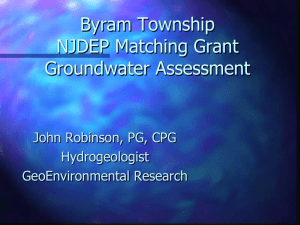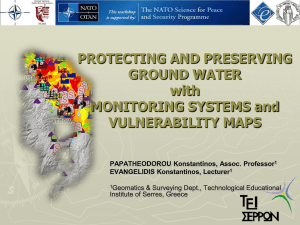Aquifer Systems for Sanitation Management - AGW-Net
advertisement

the Characterization of Groundwater Systems for Management What is groundwater? • Rainfall that soaks into the ground and moves downwards into pore spaces and cracks in the rocks becomes groundwater. • The rocks that store groundwater are aquifers. • The study of groundwater is called hydrogeology. • The study of groundwater requires an understanding of the hydrological cycle as it pertains to the recharge and discharge of groundwater and • The study of the geological formations that store groundwater is essential for a comprehensive understanding of groundwater. Groundwater USE Advantages •Widespread availability at point needed •Low cost simple technologies •Potable without treatment •Drought resistant Disadvantages •Must be pumped •Single use only •Mineralized •Difficult to assess other advantages / disadvantages? Key aspects of Groundwater • Groundwater occurs as a result of specific geological conditions in combination with specific hydrological conditions. • Aquifers exhibit porosity – the capacity to store water. • Aquifers exhibit permeability – the capacity to transmit water • Groundwater flows down the hydraulic gradient – from high head to low head (m). • Flow occurs as seepage / matrix flow or fracture flow or both. • Groundwater flows from recharge areas to discharge areas. • Aquifers may be unconfined or confined – open to atmospheric pressure or sealed by an overlying impermeable layer. • Groundwater chemistry changes naturally due to rock-water interactions in the aquifers. • Groundwater management requires reliable aquifer characterization. Porosity (stores) η and Permeability (transmits) k two basic hydrogeological parameters Sediments – granular rocks from detrital material – matrix flow Primary porosity (and dual) Fine grained and Coarse grained eg: shale, sandstone high η low k low η low k high η high k low η high k Crystalline rocks – fractures Secondary porosity with water only in the fractures – fracture flow Fracture density controls yield eg: granite, basalt Different hydrogeological environments Crystalline rock with regolith Karst limestone Sedimentary rocks of different types Unconsolidated sediments Hydrogeological diversity Unconsolidated rocks: Consolidated rocks: Consolidated rocks: • Primary Porosity • Secondary fracture porosity • Karsts (enlarged fractures) • Large storage • Small storage • Moderate storage •Locally high permeability •Low permeability •High permeability Group discussion porosity, permeability and rock type. • What rock / soil types are you familiar with? • Which have primary porosity and which have fracture porosity? • What can you say about the porosity and permeability of these rock types? • What do these parameters mean in terms of well yield? • Do all rocks of the same type have the same groundwater characteristics? • Are all rocks aquifers? • ?? Questions Groundwater Flow and the Hydraulic Gradient. Flow from high head to low head. For an unconfined aquifer, the water table defines the hydraulic head. Water table often mimics land surface. Groundwater Flow in Confined and Unconfined Aquifers Aquifer types: unconfined (free surface), water-table aquifer or phreatic aquifer. Specific yield. Perched aquifer confined (under pressure) aquifers are bounded by impervious or semipervious layers. Storage coefficient. Artesian aquifer Groundwater flow; confined / unconfined Aquifers Flow is from recharge areas to discharge areas Aquifers may be unconfined or confined, which affects recharge mechanism Artesian discharge may occur from confined aquifers Groundwater…a multi-layer system Groundwater Recharge / Discharge Interaction between groundwater and surface water Group Discussion: Groundwater Flow and Aquifer Confinement • Is groundwater flow important for groundwater management? • What is the impact of groundwater flow on recharge and discharge? • Will this have an impact of the age of the groundwater and on the water chemistry? • What are the management implications (quality and recharge) for confined and unconfined aquifers? • What is the impact of confinement on aquifer storage? Groundwater Management • • • • • • • • • • What are the key components for aquifer management? Size of the aquifer – water in storage Permeability of the aquifer – well yield Water quality – fracture flow / matrix flow Natural recharge and discharge - climate Abstraction and aquifer depletion – pumping and water levels Aquifer vulnerability – how easily polluted Pollution – point and diffuse sources of pollution Monitoring, data storage and analysis. Policy, institutions and implementation AQUIFER REPONSE: WATER LEVELS Example: Water saving to reduce aquifer depletion Historic data Baseline data (reference) Monitoring data RESOURCE SETTING HYDROGEOLOGIC CONDITIONS definition of manageable groundwater bodies resource renewability, recharge rates and sw interactions aquifer storage characteristics and economic reserves susceptibility to irreversible aquifer/ecosystem degradation SOCIOECONOMIC SITUATION analysis of groundwater use drivers (urban vs rural) (waterwell construction costs, macro-policy interactions such as energy subsidies and crop price guarantees) groundwater use and users profile MANAGEMENT INSTRUMENTS AND MEASURES POLICY ADJUSTMENTS zoning and source protection groundwater use regulation macro-policy interventions linkage with planning QUALITY MEASURES prevention adaptation water treatment remediation REGULATORY PROVISIONS DEMAND-SIDE MEASURES substitution of uses (crops, agronomy) efficiency measures/ saving water charging ACTION USER PARTICIPATION knowledge and awareness strengthening user organization local regulation SUPPLY-SIDE MEASURES natural/ artificial recharge retention alternative sourcing conjunctive management PLAN IMPLEMENTATION OF MANAGEMENT MEASURES investment priorities and scheduling of actions mobilizing stakeholder engagement and essential roles of government Aquifer Management Type Summary of key properties of the most widely-occurring aquifer types (GW Mate2, 2006) Regional distribution of global freshwasser - resources Quelle: Igor A. Shiklomanov, State Hydrological Institute (SHI, St. Petersburg) and UNESCO (Paris), 1999. Largest Aquifer Systems of the World Quelle: J. Margat (2006) Les grands systèmes aquifères du monde. Proceedings IAH Congress Dijon. SS Africa Hydrogeological setting After MacDonald et al, 2005 Specific issues for Groundwater Management • • • • Maintenance of pumping infrastructure Slowly accumulating water quality threats The hidden drought – unseen drawdown Multiple unknown users and unrecorded abstractions • Lack of information on aquifers & recharge rates • Lack of monitoring • Complex institutional management issues Maintenance issues => Lack of water supply The groundwater quality time-bomb The hidden drought 300 m Groundwater Status Quo • Millions of m3 pumped every year – Monitored? Why? Who? How? Use? quantity / quality • 100’s of thousands of users – Registered? Controlled? • 10’s of thousands of wells / boreholes – Registered? Maintained? Information - location, abstraction, water levels, water quality, formation etc - • 1000’s of sources of pollution – Location, nature & quantity of pollutants? aquifer vulnerability? • 100’s of drillers / consultants – Registered? Development & drilling data recorded & submitted? • 10’s of characterization parameters – Sampled / Analysed? Monitored? Equipped to analyse? • Many governing departments /institutions – Joint management ? Coordination / cooperation? • Unified appreciation & integrated management Government Management Issues Legislation and Regulation Economic Instruments Policy Instruments Natural Resource Management Issues Aquifer Characterization Recharge Water Quality Environmental Services Human Resources Management Issues Abstraction Rights Allocation Stakeholder Participation Capacity Building Thank You! Group Activity. Characterisation of groundwater systems Purpose: To appreciate the link between understanding groundwater systems and strategies for management Duration: 60 Minutes Scenario : 2 groups: 1)A multi-national commercial agricultural organizations submits plans to develop 150,000 ha of irrigated jatropha for biodiesel from an extensive sedimentary aquifer in south-western Zambia. The multinational defends its position citing socio-economic benefits and aquifer protection measures. 2)Catchment managers / NGO’s / small scale farmer communities raise objections expressing fears of declining water levels, and associated impacts on the groundwater system. Activity – Role Play: With reference to specific aquifer and hydrological characteristics, the two groups discuss their differences. Is the the plan is safe? What groundwater management activities should to be introduced? What sort of problems may arise? And how will they be dealt with?









